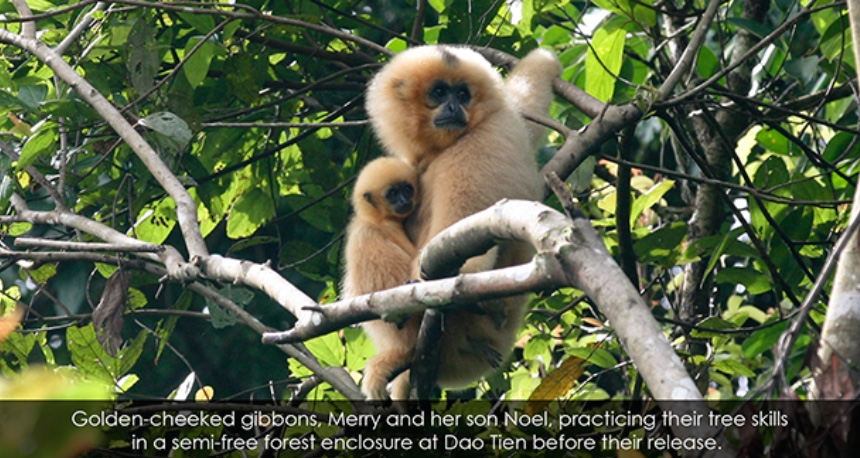
Creating a forest fit for gibbons
We are working to rectify the damage of the past and make the forest on Dao Tien richer and taller.
This, in turn, improves our rehabilitation programme, giving our tree-dwelling primates a better forest to learn the skills they will need to live in the wild.
 Forest Regeneration Scheme
Forest Regeneration Scheme
Our Forest Regeneration project is led by K’Hoai, one of our primate care staff, who has excellent indigenous knowledge of the forest and worked for years as a ranger before joining the Dao Tien team in 2008.
Since starting this project in 2011, K’Hoai, along with volunteers, collects wild seeds from the forest during different times of the year, then germinates and cultivates them in our custom-built tree nursery.
During the peak of the rains these saplings are then planted.
So far we have germinated and planted over 500 trees.
Putting right the damage of the past
A significant part of gibbon rehabilitation at Dao Tien is done in semi-wild forested enclosures.
In these areas they must re-learn how to confidently travel across the forest canopy, staying high in the trees and foraging for the fruits, leaves and insects that will make up their wild diet.
Sadly though, the forest on Dao Tien island has a traumatic post. Dao Tien only became protected forest in 2007, and before that experienced many years of opportunistic logging of hard wood trees.
In addition, heavy spraying of agent-orange during the years of warfare in Vietnam has left the forest severely damaged.
This has resulted in a mosaic of forest types, dominated in many areas by rattan and bamboo. A high density of such fast-growing species limits the natural germination of many trees, including the vital fruit trees needed by gibbons for food and shelter.
Although wild primates, including gibbons, have been found to be very adaptable to forest change, at this stage in rehabilitation, they need a good area to practice.
This project will not only benefit the primates in our care, but also the entire forest.
For example, we are planting Afzelia xylocarpa (Fabaceae) – an endangered species. Afzelia can reach 30m tall with a trunk up to 2m in diameter in a mature specimen.
Some fruit trees, such as those from the mangosteen family, can produce fruit within five years.
Get involved!
For the project to work once the young trees are planted, we need to cut back the bamboo and rattan to give the trees space to grow.
This will be a task every few months for up to four years, which takes time and money, but will result in a forest truly fit for gibbons.
You can get involved in our reforestation project through:
- Volunteer in Viet Nam: Get involved on the ground – be prepared to get your hands dirty!
- Fundraising: Raise funds for this vital aspect of our regeneration work.
- Grow trees! If your school or community group is based in southern Vietnam, we would like your help to grow saplings for planting. Please contact us at daotien@go-east.org.
